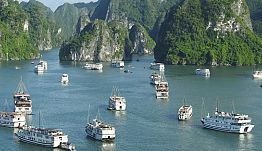
Vietnam Budget Tours
Duration: 10 Days/9 Nights
Price from: $670
Location: in South - East Asia.
Capital: Hanoi
Surface: 331 041 km2
Vietnam shares land borders with China (north), Laos and Cambodia (west),
Population: more than 84 millions inhabitants. 54 ethnic groups living throughout the country.
Religions: Buddhism, taoïsm, confucianism and christianism
Languages: Vietnamese is officiel and national. Foreign languages: English, French, Chinese, Japanese, Spanish, German and Russian.
Vietnam possess more than 3451km of coastline with beautiful beaches: Hoian, Danang, Qui Nhon, Nha Trang, Phan Thiet, Vung Tau, Phu Quoc and Con Dao (Poulo Condor) where water turquois, white sand dune and blue sky invite you a relaxing holiday.
Vietnam becomes famous for its culture and history of long date, sites listed by UNESCO's World Heritages such as Halong bay, ancient capital Hue, Hoian old town, My Son sanctuary, Phong Nha grottoes.
Hochiminh city (formerly Saigon) is the most bustling, dynamic economic and trading centre in the country. For the majority of visitors, the furiously commercial southern city of Ho Chi Minh City provides a head-spinning introduction to Vietnam, so a trip out into the rice fields and orchards of the nearby Mekong Delta makes a welcome next stop - best explored by boat from My Tho, Vinh Long or Can Tho. Heading north, the quaint hill-station of Da Lat provides a good place to cool down, but some travellers eschew this for the beaches of Vung Tau and Phan Thiet. On the road ''Mandarine'' from Nha Trang to Danang, you will explore an authentic Vietnam with stunning daily markets, superb and unspoilt beaches. Next up comes the enticing little town of Hoi An, full of wooden shop-houses and close to Vietnam's greatest Cham temple ruins at My Son. The temples, palaces and imperial mausoleums of aristocratic Hué should also not be missed. One hundred kilometres north, war-sites litter the Demilitarized Zone (DMZ), which cleaved the country in two from 1954 to 1975.
Hanoi, known as ''Small Paris'', preserves French colonial architecture with some remaining residences and villas: Opera house, Indochina bank, presidential palace...Hanoi capital is more charming thanks to the Hoan Kiem lake, located in the heart of city, pagodas and dynastic temples. From here most visitors strike out east to the labyrinth of limestone outcrops in Ha Long Bay, usually visited from the resort town of Bai Chay, but more interestingly approached from tiny Cat Ba Island. The little market-town of Sa Pa, set in spectacular uplands close to the Chinese border in the far northwest, makes a good base for exploring nearby ethnic minority villages. Enjoy the most fascinating landscapes across the Red River delta or get in touch with colorful minorities in the high mountain of Tonkin.
© Cosmos Travel Vietnam Co.,Ltd. All rights reserved.